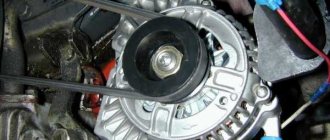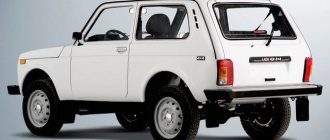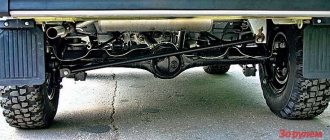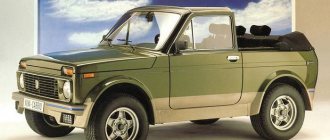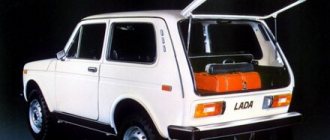Engine VAZ-21214
Engine VAZ-21213
The difference in the design of the engine, which influenced its technical characteristics, is the fuel supply system. Instead of a carburetor, the Lada 2131 Niva has a distributed injection system, which allows the engine to behave a little faster and react more quickly to fuel entering the cylinder. Recommended fuel is AI-95. The maximum speed that the car can reach is 135 km/h.
Lada 2131 1.8 Niva has an increased engine capacity - 1774, which significantly affects its speed and power. The piston stroke reaches 85mm, and the compression ratio is reduced to 8.4. At maximum speed, the engine will produce 82 hp and maximum torque - 139/3200 rpm.
VAZ-2131 technical characteristics
| Years of manufacture | 1992-1994 |
| Body type | station wagon, 5 door |
| Number of seats | 5 |
| Other name | Niva extended |
| Wheel formula | 4x4 |
| Dimensions of VAZ-2131 | |
| Length | 4520 mm. |
| Width | 1680 mm. |
| Width by mirrors | 1814 mm. |
| Height | 1640 mm. |
| Wheelbase | 2700 mm. |
| Front wheel track | 1430 mm. |
| Rear wheel track | 1400 mm. |
| Ground clearance | 228 mm. |
| Wheel size | 175/80 R16 |
| Trunk volume min | 380 l. |
| Trunk volume max | 710 l. |
| Curb weight | 1390 kg. |
| Permissible weight | 1890 kg. |
| Engine VAZ-2131 1.7 | |
| Brand | ? |
| Supply system | carburetor |
| Engine capacity | 1691 cm3 |
| Power | 79 l/s. at 5200 rpm. |
| Maximum torque | 127 N*m at 3200 rpm. |
| Camshaft position | top |
| Number of cylinders | 4 |
| Number of valves | 8 |
| Cylinder diameter | 83 mm. |
| Piston stroke | 80 mm. |
| Compression ratio | 9,3 |
| Gasoline brand | AI-92 |
| Engine VAZ-2131 1.7i | |
| Brand | ? |
| Supply system | distributed injection |
| Engine capacity | 1691 cm3 |
| Power | 80 l/s. at 5200 rpm. |
| Maximum torque | 127 N*m at 3200 rpm. |
| Camshaft position | top |
| Number of cylinders | 4 |
| Number of valves | 8 |
| Cylinder diameter | 83 mm. |
| Piston stroke | 80 mm. |
| Compression ratio | 9,3 |
| Gasoline brand | AI-95 |
| Transmission VAZ-2129 | |
| Drive unit | full permanent |
| Transmission | 5-speed manual |
| Front/rear brakes | Disc/drum |
| Steering | worm gear |
| Front suspension type | coil spring |
| Rear suspension type | coil spring |
| Performance characteristics | |
| Maximum speed | 135 km/h. |
| Acceleration time to 100 km/h. | 25 sec. |
| Fuel consumption per 100 km. | mixed cycle - 12.1 l. |
| Gas tank volume | 65 l. |
Weight and dimensions.
Niva 2131 is a restyling of the 2121 model. Mainly the car body has undergone changes. It became five-door to provide more comfortable entry for passengers. At the same time, the useful volume of the trunk has increased. All this led to a change in dimensions. The length of the car increased to 4240 mm, while the width remained the same - 1680 mm. Because of this, the wheelbase had to be increased. It is now wider than the width of the car to ensure stability when cornering.
Niva 2131 is all-wheel drive and was created specifically for off-road driving. Therefore, the ground clearance has been increased to 228 mm. This is necessary to overcome bumps and unevenness.
The Niva's trunk volume is now 420 liters with the seats folded down. The maximum useful volume is 780 liters. The total weight of the car is 1350 kilograms. In this case, the car can additionally transport up to 500 kg of cargo.
VAZ-2131 modifications
| 2131 1.7MT | 79 hp 4WD 1993 - 2003 |
| 2131i 1.7MT | 80 hp 4WD 2001 |
| 213105 1.7MT | 83 hp 4WD 2001 |
| 213105 1.8 MT | 82 hp 4WD 1998 |
| 21312 1.8MT | 82 hp 4WD 1995 |
Photo trunk of VAZ-2131
Photo VAZ-2131 five-door
Capacity displacement and “appetites” of the iron horse
All cars could be equipped with the same tanks, if not for the individual level of consumption, because this indicator cannot be ignored. Based on the characteristics declared by the manufacturer or based on personal experience, you can calculate how far you can travel with a full tank of gas. You have to count on your own less and less often, because modern vehicles are equipped with on-board computers that quickly and easily solve this problem.
The volume of the Niva 2131 tank is 65 liters. How long will this displacement last? Depends on conditions. In the city, this model “eats” approximately 11.1 liters, which means it will be possible to travel approximately 660 kilometers. If your speed is 90 km/h, then a hundred will take no more than 9 liters. This means that with 65 liters you will travel at least 700 km. The largest “appetites” are observed in the Niva at a speed of 120 km/h. In this operating mode, the vehicle consumes 12.1 liters per 100 km. And even with this consumption, you can travel more than 500 kilometers.
Transmission
The Niva 4x4 transmission system has the following filling volumes:
- transfer case - 0.79 l;
- gearbox - 1.6 l;
- rear axle - gearbox - 1.3 l;
- front axle - crankcase - 1.15 l;
- steering column - crankcase - 0.18-0.2 l.
As with the operation of a power unit, under different temperature conditions, transmission units and assemblies are filled with oils of different viscosities, which is reflected in the table:
| Lower limit of ambient temperature, °C | -15 | -25 | -25 | -30 | -40 |
| Upper limit of ambient temperature, °C | +45 | +45 | +35 | +45 | +35 |
| SAE lubricant viscosity grade | 85W-90 | 80W-90 | 80W-85 | 75W-90 | 75W-80 75W-85 |
As stated in the operating instructions, transmission lubricants need to be changed once every 30 thousand km. mileage At the same time, replacement is not provided for in the steering mechanism housing, only an addition through the top plug. The “native” oil for Zhiguli transmission units is considered to be TAD17I.
Transmission oils have good penetrating ability. Therefore, poorly clamped plugs and worn gaskets of units begin to gradually leak lubricant. In such situations, it is allowed to add oil of the same viscosity class and, preferably, the same manufacturer. If you do not top up during a leak, the lubricant level in the unit will decrease, which will lead to accelerated wear of expensive mechanisms.
Kia Soul
My wife has been asking for a long time to exchange the 2010 RAV4 for a new car, but to choose the appropriate option, with her options.
Dealer news:
New cars and used cars - tens of thousands of ads for sale. Reviews from car owners. Technical characteristics and accessories. Comparison of models and Test Drives. News from the world of cars. Prices for new cars. Promotions and special offers from car dealerships. We will help you make your choice!
This site is for informational and reference purposes only and under no circumstances constitutes a public offer.
Certificate of registration of mass media EL No. FS77-68106 dated December 21, 2016. Issued by the Federal Service for Supervision of Communications, Information Technologies and Mass Communications. 16+
Concept and history of creation [edit | edit code ]
In 1969-1970, VAZ chief designer V.S. Solovyov came up with the initiative to develop an all-terrain vehicle for residents of rural areas. His proposal was the result of the development of the so-called “type” of the USSR Ministry of Automotive Industry for 1971-1980, at that time delegated to IMZ (Izhmash). Prototypes of the AZLK-415 and −416 and Izh-14 had already been created, but these vehicles were not ready for mass production.
In the summer of 1970, Chairman of the Council of Ministers of the USSR Alexei Kosygin set the teams at VAZ, AZLK and Izhmash the task of creating an all-terrain passenger car with the comfort of mass-produced passenger models. In particular, according to the recollections of the participants in the meeting at the OGK (department of the chief designer) at VAZ, after showing him a metal-plaster model of “car No. 2” (a luxury version of the Zhiguli, later VAZ-2103), he said the following:
“Work with Fiat ends here (as stipulated by the contract), and from now on you will have to rely only on yourself. So, your first independent step should be to create an all-terrain vehicle based on the Zhiguli for our villagers. And they unwittingly found themselves deprived - we will now give millions of city residents a modern passenger car, but for the village it is of little use, especially for our “outback” [1].
In April 1971, the first technical council was held, at which the design features of the new car were chosen. Proponents of the classical approach to design offered an option with a frame body, dependent wheel suspension, and drum brakes at the front and rear. There were also more radical proposals, including a transverse layout and independent suspension. The designers began developing documentation in the summer of 1971, and already in April 1972 the first prototype was manufactured [2].
Interior of Niva 2131
The interior of the car is simple but functional. The instrument panel with analog scales and tachometer is quite informative and easy to read due to large digitization. The climate system unit, light control keys and rear window heating are located on the center console. These elements are organized compactly, and there are no problems with their use.
The main advantage of the Lada Niva 2131 4x4 is its spacious interior. The front seats do not have a profile, but optimal rigidity and the presence of lateral support bolsters provide sufficient comfort. The cars are equipped with original convertible rear seats, which allow, if necessary, to increase the luggage compartment area.
The flat floor and wide opening facilitate the transportation of large cargo. The spare wheel is located under the hood, which allows for maximum usable space. The modernization of this car has led to the introduction of air conditioning and electric windows in luxury trim levels.
Power unit
The engine installed on the modern model of the Niva 21213 (214) car was inherited from its Soviet progenitor - the VAZ 2121, and in terms of fluid volumes they are almost identical:
- Liquid cooling system. Filled with antifreeze in an amount of 10.7 liters with a freezing point not higher than -40 ° C. The capacity of the interior heating radiator is also included in this volume.
- Crankcase. Motor oils are poured here, the brand of which depends on the operating conditions. Capacity: 3.75 liters, including oil filter filling.
The viscosity of the oil poured into the Niva engine must correspond to the outdoor temperature at which the car is operated. Possible modes and suitable oil brands are shown in the table:
| Lower limit of ambient temperature, °C | -20 | -25 | -25 | -30 | -30 | -15 | -35 | -30 |
| Upper limit of ambient temperature, °C | +45 | +35 | +45 | +35 | +45 | +45 | +25 | 30 |
| SAE lubricant viscosity grade | 15W-40 | 10W-30 | 10W-40 | 5W-30 | 5W-40 | 20W-40 | 0W-30 | 0W-40 |
When flushing the power unit during the process of replacing liquid lubricant, the same amount of flushing oil (3.75 l) is used, taking into account the size of the filter. Replacement is carried out after 8-12 thousand kilometers, depending on the quality of the oil. Flushing is usually performed after 3 engine lubricant changes. During operation, it is important to monitor the oil level in the engine crankcase using a special dipstick. If the level drops below the Min mark, it is urgent to add lubricant to the engine of the same viscosity as was previously filled.
Photos of the salon
In the Niva Urban with 5 doors, the passenger seats have undergone some changes (unlike the three-door model). The new chairs are supplemented with elements of lateral support, which increases comfort and convenience for the seated person. The seats are covered in dark velor with white stitching, which visually makes the interior more attractive. The dashboard has not undergone any significant changes; the only innovation here is the appearance of a regulator that controls the air conditioning. The central control panel has buttons for turning the heated seats on/off.
All about the new AvtoVAZ LADA 4x4 SUV
No matter how much abuse the auto community and domestic car enthusiasts pour out at VAZ, the largest automaker still tries to monitor changes and new trends in the market. Although this happens with a considerable delay. The idea that the Niva, so beloved by the people, was hopelessly outdated has been in the air since 2012, but they still started modernizing it, albeit quite late. Representatives of AvtoVAZ collected information, conducted surveys, and in 2014 the first copies of the urban version of Urban rolled off the assembly line. 2 years later, a version with 5 doors appeared. Today we will talk about what the 5-door Niva Urban is.
Technical characteristics (3-door, 5-door and Urban). Lada 2131 technical specifications
Niva 2131: technical characteristics of a 5-door car
The five-door Lada Niva 4x4 is a compact, unpretentious, reliable SUV designed for transporting passengers and luggage at air temperatures from -40 °C to +45 °C. This car is distinguished by a suspension that provides excellent ride comfort and absolute immunity to road irregularities. The five-door VAZ 2131 is the most spacious car in the Niva 4x4 line.
Return to contents
Dimensions, weight, load capacity
The vehicle has characteristics such as length, width, height. These indicators help the driver assess how much space the car occupies on the road. Length is the distance between the maximum protruding parts in front and behind. The width is determined by the boundaries of the side mirrors. Height is measured from the surface on which the vehicle is located to the highest point on the roof of the vehicle.
Basic methods
The actual fuel consumption of the Niva 2131 can be reduced due to the weight of the car.
You can get rid of unnecessary parts of the vase, which provide comfort, but take away gasoline. Driving style is an important factor influencing the engine's use of gasoline: the more extreme, harsh driving style, the more fuel will be consumed. Change your driving style to a more relaxed one, and you will pay less for gasoline in the face of rising prices.
Installing an injector is the most effective way to reduce fuel consumption, the only problem is that if the injector is already installed, the situation will not change. Gasoline consumption on a Niva leads to the data indicated above, that is, without them, the Niva will “eat up” much more fuel.
Problems and solution
It may surprise you, but even open windows increase fuel consumption, especially in city conditions. It’s quite simple to explain: the aerodynamic properties of the car are somewhat reduced, which is why the air resistance in the Niva’s cabin increases, as a result of which the need for fuel is much greater.
The mechanics inside the cabin absorb some of the fuel from the fuel tank, for example, the air conditioner is powered directly from the Niva engine, and electrical equipment (for example, a radio) is powered by a battery connected to the engine, which also increases fuel consumption; avoid music on the road or the air conditioner , and you will pay less for fuel.
There is another simple algorithm:
- reducing the friction force in the engine will reduce fuel consumption;
- this is not difficult to do: you just need to regularly lubricate the parts with engine oil;
- the oil must be of high quality, otherwise there will be no effect;
- It is better to use high viscosity motor oil;
- increasing the pressure in Niva tires will reduce gasoline costs;
- the same laws of physics apply here: pumped by no more than 0.3 atm. tires will help reduce speed and friction with the road.

